All About Canned Tuna – And How to Eat it Safely & Deliciously
Proteins do not contain any FODMAPs, so that can of tuna on your shelf is just waiting to be turned into a low FODMAP meal or snack. Tuna salad? Sure, we’ve got a few of ‘em (Classic, Pasta and Mediterranean – more to come), but this article is about thinking outside of the box – or can, as the case may be.
We are about to show you all about canned tuna and how super versatile it can be.
A Tuna Primer
But first a Tuna Primer. Not all canned tuna is created equal. Now, you probably know there is water packed and oil packed but there is actually much more to know.
As an aside, tuna was first packed in the U.S. in 1903 and has been an economical protein choice ever since!
Is Water-Packed Tuna Packed in Water? Not Always!
Let’s address water packed for a moment. You probably think that your water packed tuna is packed in…water! Guess what? Look at the label below. Are you as shocked as we were to see “vegetable broth” on there?
This is actually the case for most of the commercial and common brands in the U.S. including Bumble Bee, StarKist and Chicken of the Sea. See the image below.
The issue is that “vegetable broth” might contain garlic and/or onion. We called all of these companies to get to the bottom of this for you and some of the calls went better than others.
Here’s what we found out:
- Bumblebee: All of their tunas that state “vegetable broth” on the label contain a broth made from “carrots, peas, green and red bell peppers, onion, parsley, celery and garlic”.
- StarKist: All of their tunas that state “vegetable broth” on the label contain a broth made from “carrots, celery, garlic, onions, parsley, peas, soybeans, tomatoes and potato extract”.
- Chicken of the Sea: All of their tunas that state “vegetable broth” on the label contain a broth made from “one or more of the following vegetables: beans (including soy beans), cabbage, carrots, celery, garlic, onions, parsley, peas, potatoes, green bell peppers, red bell peppers, spinach and tomatoes”. Calls to corporate could not discern the exact blend, although they kept repeating that if you have an “allergy” (their word) to any of the ingredients that you should not eat any of their products made with vegetable broth.
Why Does Canned Tuna Contain Vegetable Broth?
Chicken of the Sea addresses the use of vegetable broth on their website as follows:
“Why do we add vegetable broth to the canned tuna? Vegetable broth is added to our canned tuna as a flavor enhancer, resulting in a milder flavor.”
I guess these manufacturers don’t think that consumers want their fish to taste like fish!
This is ridiculous, in our opinion, as there are many great quality canned tunas that are actually packed in water that taste fabulous.
Make Sure Water Means Water!
But don’t fret! There are many canned tunas available that are actually packed in water with no hidden FODMAPs! And, as a benefit they tend to be better products.
They will also cost more, but before you clutch your wallet, look at the images farther below, showing what various tunas look like (shreds vs. chunks) and also how much liquid is in various cans.
On the top is Wild Planet brand, which we love, and as you can see, the ingredient is simply TUNA! On the bottom is a brand called Pole & Line. Their albacore white tuna cans contain tuna, water and salt. Both of these are low FODMAP safe.
How to Buy Canned Tuna
So what should you be looking for when it comes to canned tuna? We are considering taste, health and environmental impact.
Of course read labels – even the tops of the cans! And visit brand websites as needed.
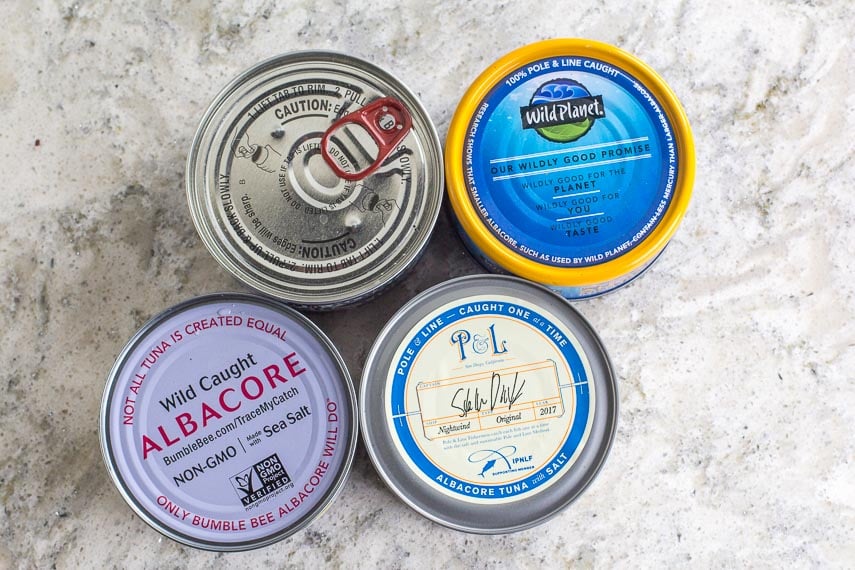
- Upper left we have a Trader Joe’s Solid White Albacore in Water (and it is in water and salt only). They simply use their lid to give you safety instructions in regards to opening the can.
- Upper right we have Wild Planet Albacore Wild Tuna and the lid further educates us to the fact that the fish is 100% line caught and that their smaller fish contain less mercury than the larger albacore fish that some brands use.
- Lower left is Bumble Bee Solid White Albacore in Vegetable Oil. Their lid tells us that their tuna is wild caught and they provide a URL so that you can “Trace My Catch”. They are members of the ISSF (International Seafood Sustainability Foundation), which you can read up on as to their credibility. Their funding largely comes from corporations, such as canned tuna fish manufacturers.
- Lower right is Pole & Line Albacore and they pack their lid with information like the name of the ship and captain and that they are a member of IPNLF (International Pole and Line Foundation).
Our point of showing you all of this above is to make the point that some of the brands are very good at marketing and can make their product appear to be “better” than it might be in actuality. We leave it to you to ultimately make your own decisions. We are partial to Wild Planet and Pole & Line brands.
See the section below on How to Buy Tuna That Doesn’t Hurt The Environment.
Taste That Tuna
There is no one “best” type of tuna when it comes to taste. The most common will be Albacore (also called “White”), Skipjack (also called “Light”) and Yellowfin.
Then, each of those might be packed in water, vegetable broth, vegetable oil or olive oil, whether they are canned or packed in glass. You can also find tuna packed in pouches, which whether it is in oil or water tends to be a drier product.
You won’t have to drain it, which eliminates a preparation step, which also saves time and mess. You will pay more for the pouches.
You can also find low sodium versions of pretty much all of the above.
Some folks are light tuna fans, while others like white and all tuna is low FODMAP, being protein, so buy what you like or use what is called for in specific recipes.
Costs Less? You Get Less!
The standard size of most cans of tuna is 5-ounces or (142 g), but let’s look at how much tuna you get! All companies will take the weight of the can out of the equation, but take a look at the image below.
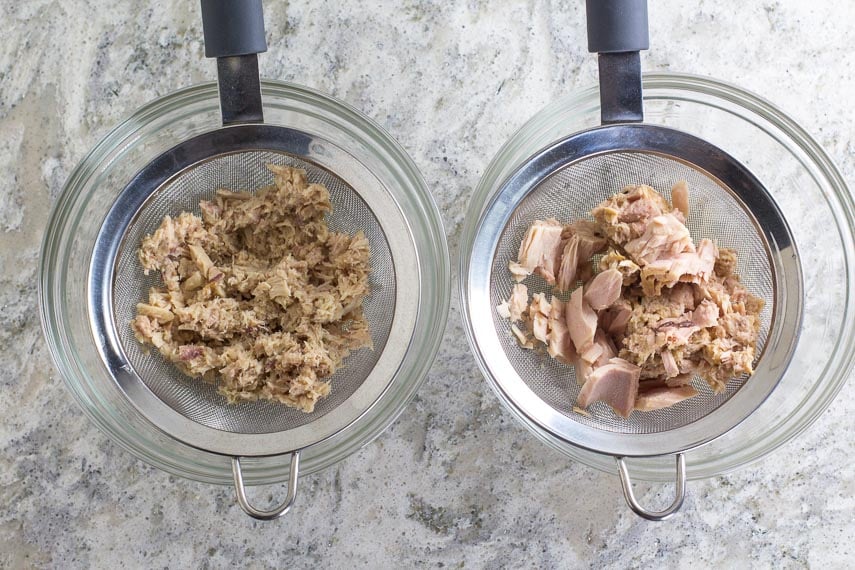
Now look at these images below.
The Bumblebee on the left contains much more water weight and the tuna itself is shreds! The Whole Foods 365 brand on the right contains much less liquid and as you can see, the tuna itself is much more substantial.
Take this into account when you are comparing prices.
Eat Your Mercury?
The issue of mercury content in canned tuna has been discussed for years. Basically pollution releases mercury into our environment, including the oceans. Larger fish like tuna accumulate more mercury than smaller fish because they are eating all those littler fish.
The FDA keeps up-to-date with guidelines, which suggest that pregnant women and children should watch their intake. There are nutritional benefits to canned tuna as well, so up to twice a week should be fine for most of you.
Light, or Skipjack, tuna will contain lower mercury levels according to the FDA and the EPA.
How to Buy Tuna That Doesn’t Hurt The Environment
The environmental issue with tuna is how it is fished. Some tuna is fished using the “purse seine method”. With this technique, large nets are cast and while tuna might be the target fish, many other fish and sea creatures might get caught up in the net, including endangered or protected species.
These creatures are the “bycatch”. This non-targeted and non-specific approach leads to over-fishing of the oceans.
What is Dolphin Safe Tuna?
Let’s get one thing clear: “dolphin safe” doesn’t mean ocean safe. The World Trade Organization (WHO) has been battling this issue for years, attempting to bring clarity to the consumer.
Since 1990 the “dolphin safe” term started popping up within tuna marketing. This was referencing the fact since some tuna (often noted as yellowfin) swim along with dolphin pods, and that if the tuna were fished using net-casting methods, were chased or encircled, that dolphin would be harmed.
The problem is that even if this method is not used, any tuna caught in the eastern tropical Pacific can only be called dolphin-safe if an independent observer verifies that no dolphins were harmed. (Who is watching the observer?)
Tuna caught anywhere else in the world can be called dolphin-safe with a simple declaration from the ship’s operator. (What are their credentials or preferred end results?). We aren’t making an claims one way or another, we are just pointing out that the system is not fail-safe.
Additionally, Americans in particular will envision Flipper, the beloved dolphin character of 1960s TV, and so seeing the words “dolphin safe” tugs at emotions and we think buying dolphin safe is a good thing.
Who doesn’t want to save Flipper? Activists will point out that this marketing term completely ignores the fact that rays, turtles, sharks, marlins and other sea creatures might be, and probably are, harmed.
For now, we do not recommend using “dolphin safe” labeling as your main guide.
Read The Labels!
Read labels and look for wording that says “pole and line caught” or “troll caught”, which means the fish were caught one at a time and not in those catch-all nets.
You can also look for certifications such as the MSC (the Marine Stewardship Council) seal or look at lists compiled by Seawatch.org and seek out tuna that is designated by them as “Best Choice” or “Good Alternative”, but steer clear of those with the “Avoid” stamp.
Whole Foods has had a policy enacted for years that states that any tuna that they sell will be traceable from the boat and all the way to the can.
They will only sell tuna that is sourced from fisheries that use pole, troll, or hand-line catch methods and are certified by the Marine Stewardship Council or rated a “Best Choice” or “Good Alternative” by the Monterey Bay Aquarium, who created Seafoodwatch.org.
Greenpeace also publishes lists of canned tuna brands addressing their ethical and sustainable approach to tuna fishing. Wild Planet is also well received.
Tuna Packed in Glass
You might have noticed in our images that some of the tuna is packed in glass. There are a few companies that offer this option and this tuna, while usually pricier, is also often of truly exceptional taste and texture.
We love Tonnino brand and will use it when making a Salad Nicoise for instance.
We look at this type of prepared tuna as its own thing. It isn’t fresh tuna steak, but it is typically light years beyond everyday canned tuna. Use it when you want some thing a little special. We have also put it to great use in our Low FODMAP Pantry Pasta with Tuna, Lemon & Olives.
We highly suggest that you keep a jar in your low FODMAP pantry; you will never be without an easy meal!
For dozens of ways to put those cans and jars of tuna to work, check out our article, 18 Ways to Use Canned Tuna. We have awesome recipes from salads, to casseroles, sandwiches, pasta and more.
- Low FODMAP Pasta with Tuna & Sun Dried Tomatoes
- Low FODMAP Mediterranean Tuna Salad with Chickpeas
- Low FODMAP Pantry Pasta with Tuna, Lemon & Olives
- Low FODMAP Tuna Macaroni Salad
- Low FODMAP Tuna Pan Bagnat – aka Best Tuna Sandwich Ever
- Low FODMAP Tuna Salad
- Low FODMAP Salade Niçoise
Low FODMAP Recipes Created Just For You!
We take low FODMAP recipes seriously at FODMAP Everyday®. That’s why Dédé oversees our Test Kitchen and makes sure that each and every recipe works – and is low FODMAP following the most up-to-date science.
Read our article How Are Low FODMAP Recipes Created? for more in-depth information.
Rest assured that you will not find more trustworthy or delicious low FODMAP recipes anywhere – several hundred and counting.
FODMAP Everyday®Low FODMAP Recipes At A Glance:
- FODMAP Everyday®is accredited by FODMAP Friendly.
- Dédé is low FODMAP trained by Monash University.
- Dédé is also individual accredited as a recipe developer and FODMAP educator by FODMAP Friendly.
- We maintain our own professional Test Kitchen.
- Dédé has over 30 years of professional recipe development experience, including her stint as a Contributing Editor for Bon Appetit magazine and has written 17 cookbooks.
Come Join Our Low FODMAP Recipe Community!
Use Our Exclusive Recipe Filter To Find The Low FODMAP Recipe You Are Looking For Today!
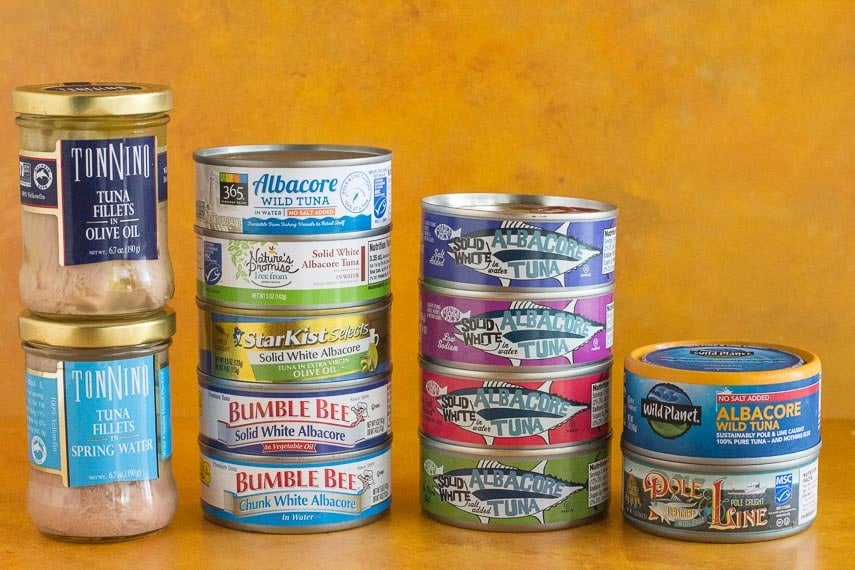

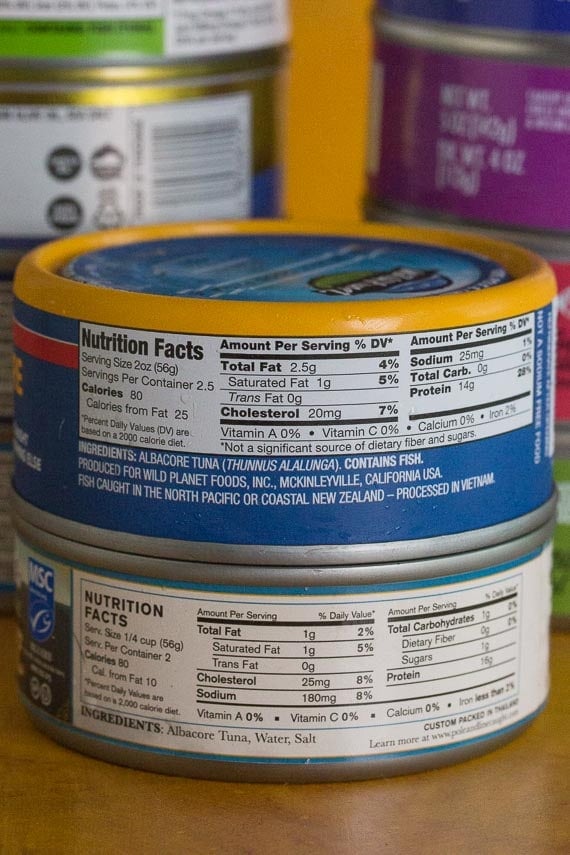
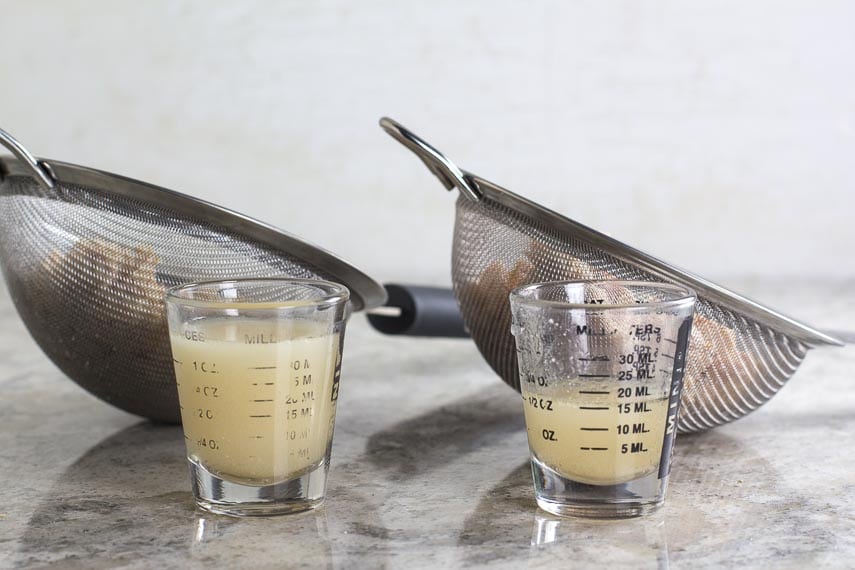
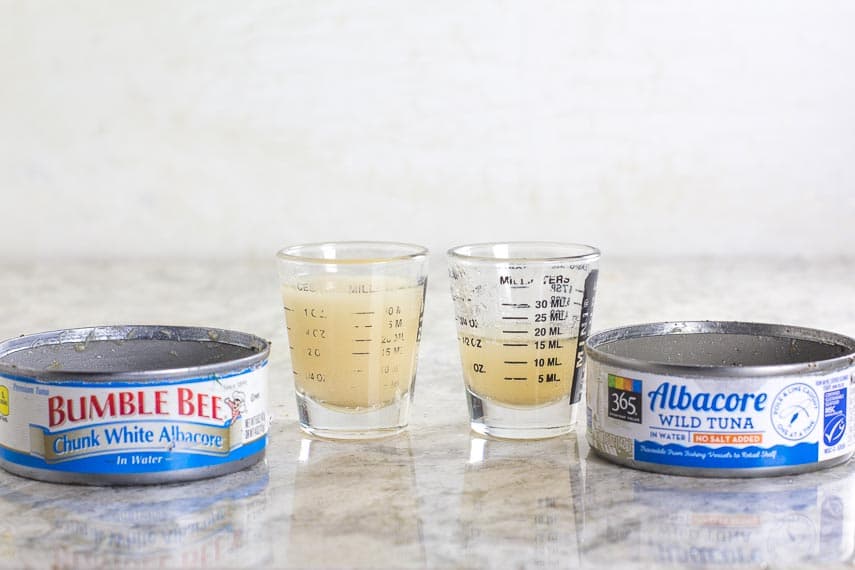
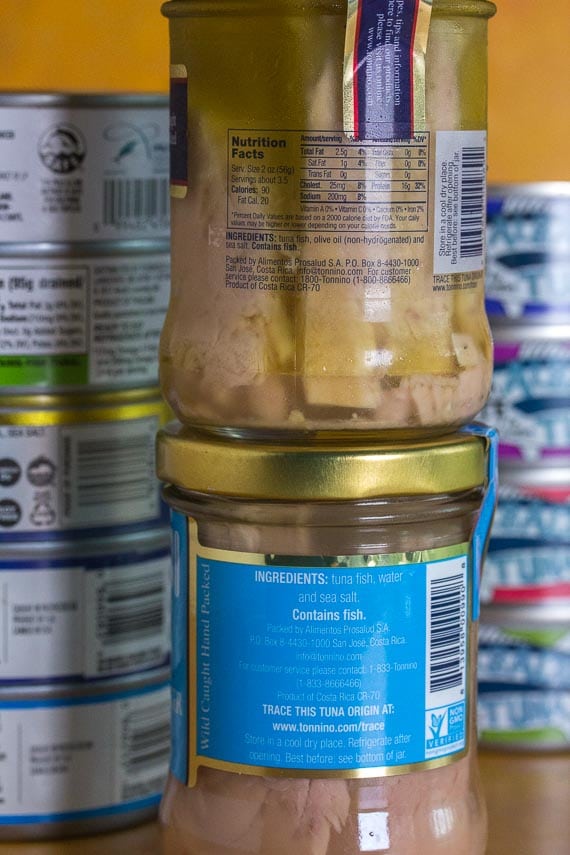







Thanks for this article! I never thought to read if there’s more than water in the can. I had a can of Wild Planet and loved it. Husband got another brand and it’s not as tasty and probably has broth in it as I haven’t been feeling too good lately. Now I might know why since I’ve been having a tuna sandwich for the past few days AND I was just getting ready to make another one after reading this article. Not now! Off to get more Wild Planet!
Laura, we are so happy the article was of help. The whole water thing confounds us. I believe it is deceptive labeling! Hopefully tuna will now sit better with you, buying an appropriate low FODMAP brand.
Great article – I’ve been a fan of Wild Planet for years. But I recently had to give up tuna due to histamine issues in canned fish – even Wild Planet provokes the reaction. Do you know if tuna in glass jars would be any less likely to have histamine?
Fascinating question! We are actually working on a food chemical sensitivity article right now! I reached out to our RD Vanessa and will get back to you.
From Vanessa:…any tuna that has been canned or processed in a manner to extend shelf life if likely high in histamines. The only way to keep histamine and take low is to eat fresh tuna or freeze immediately to slow down the protein degradation. I did not see anything (in her research) about different storage containers affecting histamine levels.
Thank you Dede and Vanessa – very helpful. Looking forward to your article on food chemical sensitivity!
I live in the northwestern part of the US and haven’t seen your recommended brands in our supermarkets. I buy Bumble Bee wild-caught gourmet tuna. Ingredients are simply white tuna and water. Perhaps not as tasty as some but should be FODMAP friendly, right?
That is fine! And the thing with the “brine” is that there could be very small amounts of high FODMAP ingredients that most people will not react to at all – but it is good to know they are in there in case you are and are stumped about symptoms.
Very good article & thank you for calling the companies and getting more info. Can you please share your thoughts on rinsing the Canned White Albacore Tuna in water? Would rinsing Bumble Bee white albacore tuna in water make it low fodmap? It shows yellow on the spoonful app because of the broth.
Hi Aida, no one can tell for sure without lab testing. Your tolerance will depend on sensitivity. Let’s just say for discussion sake that there are onion or garlic in the broth. They would not only be present in the broth, but the fructans would also leach into the tuna. How much? Not much, but again, this is where your sensitivity comes in. Would rinsing it improve the outcome? Yes, somewhat.
I have a different problem. My body holds onto heavy metals, and I got mercury poisoning from all the tuna I ate. We have found either zero or trace amounts in one brand Costco carries, and I can eat it safely. Do be aware if you eat a lot of tuna that this can happen. Just fyi.
So sorry that happened to you. I don’t know if you missed the section, but this is addressed in the article.
Hello – super helpful. Thoughts on the Trader Joe’s brand if tuna?
Hi there! They have many kinds. If you would share the label I will take a look. Also, did you know we have a TJs Shopping List?